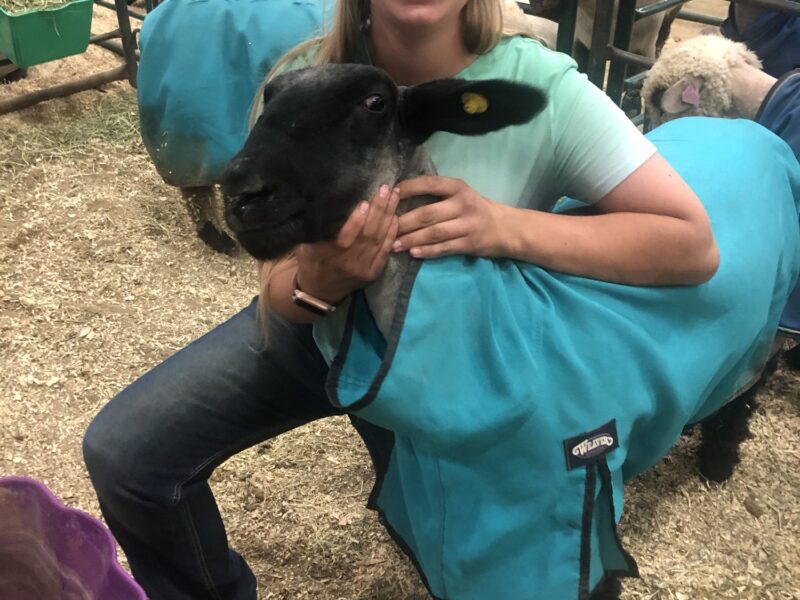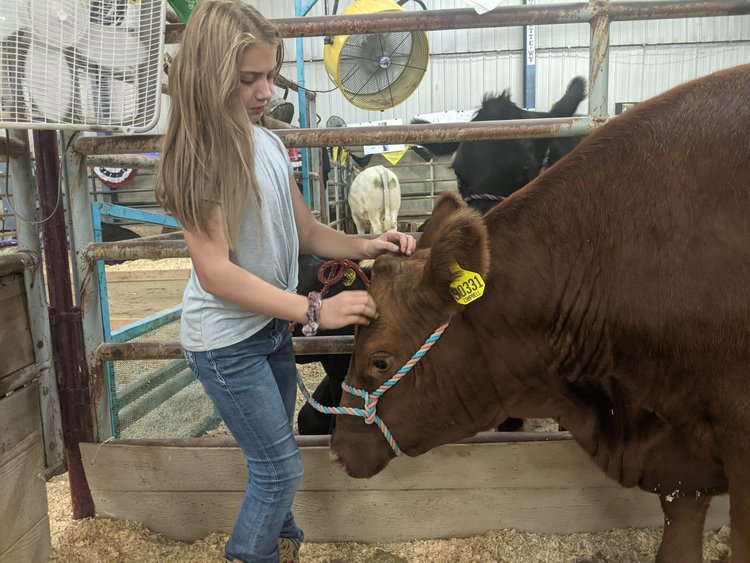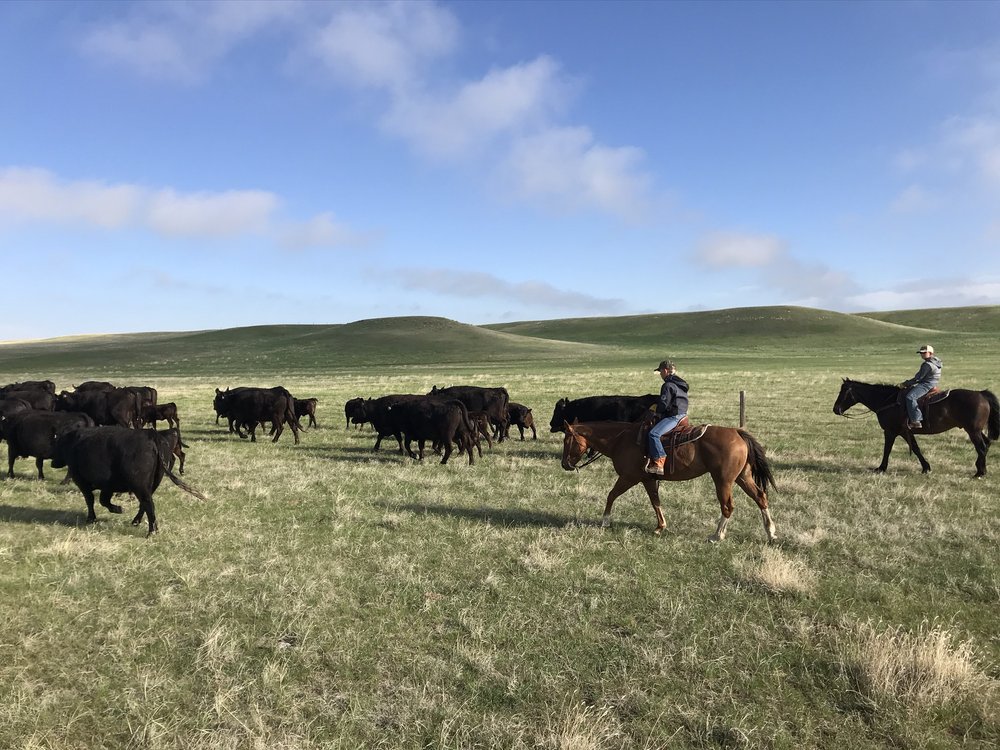Wyoming’s Escalating Land Prices Create Barriers for Young Ag Producers
As interest in ag education continues to rise, youth look for new opportunities
- Published In: Other News & Features
- Last Updated: Aug 06, 2022

Bailee Behnke, 13, practices her sheep-handling skills on Cheyenne, her 1-year-old buck ram, before the recent contest at the Campbell County Fair in Gillette. (Wyoming Truth photo by Jen Kocher)
By Jen Kocher
Special to the Wyoming Truth
Gillette, Wyo.—Cheyenne the sheep made a dash across the dirt pen as 13-year-old Bailee Behnke attempted to corner him to slip on his halter. In the adjoining corals, neighboring sheep bleated in collective commiseration from behind the wooden slats in the makeshift pens at Cam-Plex in Gillette.
Haltering is by far the hardest part of showing a sheep, the teenager explained, as she steadied Cheyenne’s head between her hands to demonstrate the showmanship skills she practiced for several months.
Behnke is one of thousands of youth in 4-H and Future Farmers of America (FFA) chapters statewide who are testing their animal showmanship skills at state fairs throughout Wyoming.
Last week, Behnke and other Campbell County youth competed before judges and participated in a livestock sale to recoup a portion of their investment.
They’re part of a growing trend: While the average age of over half of Wyoming’s producers hovers around 55, FFA members and youth are increasingly attracted to careers in ag.

Casey Styvar, 44, a technical education teacher and FFA advisor at Campbell County High School, is seeing an uptick in FFA participation, with about half of his roughly 40 members coming from non-traditional agricultural backgrounds. County fairs are one of the best venues for recruiting young people to pursue careers in agriculture, he said. Much like working ag producers, the kids get firsthand experience raising their own livestock and learning how the market works.
Many of the non-traditional participants are “city kids,” Styavar said, who are drawn in by the animals and opportunity to be outdoors. Even without land and livestock of their own, the club collaborates with area ranchers or the fairgrounds to provide resources, so all interested youth can participate, Styvar said, even if that means making room in their classroom.
Lack of land major barrier for young producers
This steady uptick in the Gillette FFA chapter mirrors that of Wyoming, according to Stacy Broda, state FFA advisor. Following a slight downturn during COVID, the membership has grown to over 1,500 youth across 58 chapters throughout Wyoming middle and high schools.
But the rising interest in agriculture is at odds with a 2014 “Society for Range Management Journal” article that predicted there will be no ag operators in Wyoming under the age of 35 by 2033. The study tracked data from the U.S. Census of Agriculture, and with the exception of two counties, Sweetwater and Natrona, the average age of operators ages 34 and younger declined significantly over time.
This decline has no bearing on the next generation’s interest in the ag industry, but rather is being driven by a disappearing landscape.
The study’s authors concluded that the major barrier for young producers is a lack of farm and ranchland; it’s being converted for housing developments or sold to corporate ag producers. In many cases, depending on the inheritance tax, land owners can’t afford to pass on their properties to their heirs and find it more lucrative or necessary to sell it.
The price of land in Wyoming, too, is soaring as supply becomes more limited.
An Aug. 3 posting on LandWatch, an online real-estate company, listed 416,153 acres of rural property for sale in Wyoming for an average of $1 million per parcel—a combined total value of roughly $2 billion. In 2019, Wyoming had around 12,000 registered farms and ranches, according to 2020 survey data from the United States Department of Agriculture (USDA) Wyoming field office, with the average size around 2,417 acres. Between 2020 – 2021, the price of farm and ranchland real estate increased by over 5%, according to the same data, to just under $800 per acre.

“You have to love what you are doing”
On top of rising land prices and limited availability, shrinking returns – particularly in drought years with record-high feed and diesel prices – also make it harder for young producers to get into the game.
“You have to really love what you are doing and be able to make a living at it,” Broda said.
For Broda and her husband that was never in question. The couple left their teaching careers to return to her family’s ranch, located approximately 15 miles from Cheyenne’s city center, when they got married in 2006. Though the ranch looks much different than it did when she was growing up—it’s now surrounded by housing developments—their love of ranch life is what brought them home. It’s where they wanted to raise their two boys, now ages 12 and 14.
“I always knew I’d come back,” said Broda, 42, a fifth-generation rancher. “I just did it a lot sooner than I thought.”
Broda and her family are lucky, she acknowledged, because they already owned land—a precious commodity that she plans to keep in the family. Even so, it’s becoming harder to “pencil out” running cows on drought-dried land for what it costs to run the operation. This year, they sold off calves about a month earlier because of a shortage of viable grassland, which cut into both their herd and profits.
Despite limited opportunities in traditional ranching and farming, Broda said that opportunities still exist in agriculture, such as veterinary medicine, fertilizer sales and marketing. One of her former students, for example, sells livestock vaccines and pharmaceuticals.
“We just need to do a better job educating kids about these other opportunities,” she said. “And you have to really have a passion for this way of life.”
Preserving heritage
Campbell County rancher Marilyn Mackey agreed. Mackey and her husband, Dudley, ranch on her family’s homestead on 6,000 acres of deeded and leased ranchland, about 20 miles north of Gillette. The couple bought Marilyn’s grandfather’s portion after he died.
“At the time, we didn’t know how we would pay for it,” she said, “but we knew it was the only opportunity, so we made it work.”
The trouble with their ranch, Mackey said, is that there’s not enough land for one person to earn a living. So they all hold second jobs. Dudley worked at a nearby coal mine; Marilyn raised their son and daughter—both of whom returned after college and built homes on the ranch. Now, they are raising their families while ranching and working in accounting and the energy sector.
For Mackey, it was never a question of leaving the land her great-grandparents built with their own hands.
“Our goal is to preserve it for our family,” she said. “That means being creative and getting lots of additional jobs. I never wanted to do anything different and feel blessed every single day to live on this ranch and in this community doing what we love.”
Mackey believes that ag education is vital to encourage future generations of ranchers. To that end, she recently co-chaired the stewardship project for Wyoming Ag in the Classroom.
As for Behnke, she is unwavering about her future: the third-generation rancher plans to return to her family’s cattle ranch after college. Behnke doesn’t worry about the hard work or relatively low profits, she said, because she loves the animals and can’t imagine a life outside of ranching.
But unlike her parents, Behnke is contemplating a career as a veterinarian.













